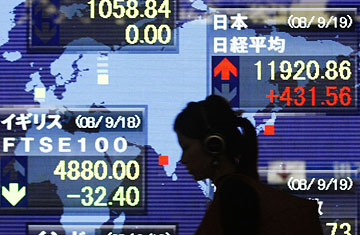
A woman walks in front of an electronic board displaying movements in major indices in Tokyo on Sept. 19
Ten years ago, Asian bankers got a good finger-wagging from their American and European counterparts as the region's financial sectors melted down in a major crisis. Today, Asia has the right to do some finger-wagging of its own.
As the U.S. financial crisis deepens, Asia has looked on nervously, but with little fear of getting dragged into the maelstrom. Asian financial institutions have generally avoided the kind of risky, subprime mortgage-related investments that have crippled financial firms in the U.S. and Europe. Fitch Ratings figures that at mid-year Asian banks accounted for only 6% of the total losses on subprime investments at the world's banks. (European banks, on the other hand, were responsible for 47%.) Even those financial institutions that carried some exposure — like Japan's Mizuho Financial Group, which has reported subprime-linked losses of more than $6 billion through June — are considered strong enough to ride out the storm. Jesper Koll, Japan director for Singapore-based Tantallon Capital, says Japanese financial companies "are a sideshow to what is going on."
This isn't to say that Asia hasn't been affected by America's financial woes. Asian stock markets, despite a recent rally, have tumbled in recent months on concerns over the state of the U.S. economy. Losses may also continue to mount as the financial crisis in the U.S. unfolds. Major Japanese banks, for example, have some $3 billion in exposure to Lehman Bros., which filed for bankruptcy last week. Individuals have also been hurt. In Hong Kong, hundreds of residents who purchased Lehman bonds held a protest on Sunday demanding the government help secure their investments.
But Asia's financial systems "are not expected to face a crisis situation," according to a Standard & Poor's report released this month. The primary reason is that the region's banks had little need to dabble in high-risk U.S. mortgage investments. With economies roaring at home, they found ample opportunities for profit. "They had a lot better things to do with their money," says Deborah Schuler, group credit officer at Moody's in Singapore. "There is real growth in Asia and they were financing it."
Banks also learned lessons from the 1997-98 financial crisis, which was partly caused by weak risk management. Lenders haphazardly tossed money at conglomerates for questionable industrial projects and property investments, and they chased high-yield, high-risk investments around the globe. But they paid the price in bank and finance company failures. In August 1997 Thailand closed 42 finance companies, Indonesia closed 16 banks two months later, and South Korea closed 14 merchant banks in December 1997, according to Merrill Lynch. Others were sold or merged. Those that survived cleaned up their act. Credit analysts are more thoroughly trained and better technology systems allow managers to more carefully assess the risk in their portfolios. As a result, Asia's financial institutions are much more conservative than in the past.
The region might be safe for now, what the future holds is unclear. Asia's economies, though far from recession, are decelerating as a result of the overall global slowdown. That could lead to problems at home, including rising nonperforming loans. "Asian banking systems might have dodged the turmoil from the U.S. subprime crisis but they are not immune to economic slowdowns," Standard & Poor's concluded. In these turbulent times, avoiding one bullet doesn't necessarily save you from others.
—With reporting by Coco Masters/Tokyo
